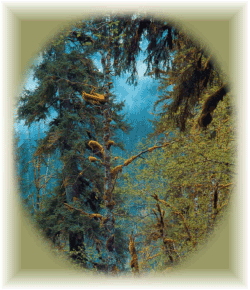 References
References
 References
References
Bodley, Peter. 1990. Examination
of fish/forestry interactions of coastal streams in
British Columbia : forest practice influences on salmon habitat.
Brannon, Robert D. and Interagency
Grizzly Bear Study Team. 1984. Influence of roads
and developments on grizzly bears in Yellowstone National Park.
[Bozeman,
Mont.: Interagency Grizzly Bear Study Forestry Sciences Lab Montana State
University.
British Columbia, Ministry of Environment
Lands & Parks. 1995. "A future for the
grizzly: British Columbia grizzly bear conservation strategy." Province
of British
Columbia Ministry of Environment, Lands and Parks, Victoria, BC.
British Columbia, Ministry of Forests.
1999. "Managing Identified Wildlife: Procedures
and Measures Volume 1." Ministry of Forests, Forest Practices Code.
Clapp, R. A., J. C. Gauci, and N.
R. Hollis. 2000. "Conservation-based Development in
British Columbia's Central Coast." in Environmental Workshop, edited
by R. A.
Clapp, J. C. Gauci, and N. R. Hollis. Burnaby, BC: Simon Fraser University,
the
Department of Geography [unpublished paper].
Craighead, John Johnson, G. B. Scaggs,
and J. S. Sumner. 1982. A definitive system for
analysis of grizzly bear habitat and other wilderness resources utilizing
LANDSAT multispectral imagery and computer technology. Missoula, Mont.:
U
of M Foundation University of Montana.
Fuhr, Brian, D. A. Demarchi, British
Columbia. Habitat Inventory Section., and British
Columbia. Wildlife Branch. 1990. A methodology for grizzly bear habitat
assessment in British Columbia. Victoria, B.C.: Habitat Inventory Section.
Hamilton, Anthony Neil. 1987. Classification
of coastal grizzly bear habitat for forestry
interpretations and the role of food in habitat use by coastal grizzly
bears.
[Vancouver, B.C.]: University of British Columbia.
Hamilton, Anthony Neil, Colleen
A. Bryden, C. J. Clement, Canada. Forestry Canada.,
British Columbia. Ministry of Forests., Canada-British Columbia Forest
Resource
Development Agreement., and Canada/BC Economic & Regional Development
Agreement. 1991. Impacts of glyphosate application on grizzly bear forage
production in the coastal western hemlock zone. Victoria, B.C.: Forestry
Canada.
Haroldson, Mark, David J. Mattson,
and Interagency Grizzly Bear Study Team. 1985.
Response of grizzly bears to back country human use in Yellowstone National
Park. Bozeman, MT.: Interagency Grizzly Bear Study Team Forestry Sciences
Lab Montana State University.
Jeo, Richard M., M. A. Sanjayan,
and Dennis Sizemore. 1997. "A conservation area
design for the Central Coast region of British Columbia, Canada." Round
River
Conservation Studies, for the Sierra Club of BC, Greenpeace, the Forest
Action
Network, and the Raincoast Conservation Society, Salt Lake City, Utah.
Keeley, E. R., P. A. Slaney, Daiva
O. Zaldokas, and Watershed Restoration Program
(B.C.). 1996. Estimates of production benefits for salmonid fishes from
stream
restoration initiatives. [Vancouver]: British Columbia Watershed Restoration
Program.
Laderman, Aimlee D. 1991. "Coastally
restricted forests.".
Mace, Richard D., John S. Waller,
Timothy L. Manley, Katherine Ake, and William T.
Wittinger. 1999. "Landscape Evaluation of Grizzly Bear Habitat in Western
Montana." Conservation Biology 13:367-377.
MacHutchon, A.G., S. Himmer, and
C.A. Bryden. 1993. "Khutzeymateen Valley grizzly
bear study : final report." A cooperative project of the Ministry of Environment,
Lands and Parks and the Ministry of Forests.
McAllister, Ian, 1969-. "The great
bear rainforest : Canada's forgotten coast / Ian
McAllister & Karen McAllister, with Cameron Young ; photography by
Ian
McAllister ; foreword by Robert F. Kennedy Jr.".
McCormick, James Edward. 1999. A
food-based habitat-selection model for grizzly bears
in Kluane National Park, Yukon. [Vancouver]: University of British
Columbia.
McLellan, Bruce Norman, Fred W.
Hovey, Richard D. Mace, John G. Woods, Daniel W.
Carney, Micheal L. Gibeau, Wayne L. Wakkinen, and Wayne F. Kasworm. 1999.
"Rates and causes of grizzly bear mortality in the Interior Mountains of
British
Columbia, Alberta, Montana, Washington, and Idaho." Journal of Wildlife
Management 63:911-920.
Munro, Robin Helen. 1999. The
impacts of transportation corridors on grizzly and black
bear habitat use patterns near Golden, B.C. [Vancouver]: University
of British
Columbia.
Noss, Reed F., Michael A. O'Connell,
and Dennis D. Murphy. 1997. The science of
conservation planning : habitat conservation under the Endangered Species
Act.
Washington, D.C.: Island Press.
Purves, Helen D., Clifford A. White,
and Paul C. Paquet. 1992. "Wolf and grizzly bear
habitat use and displacement by human use in Banff, Yoho, and Kootenay
National Parks : a preliminary analysis." Canadian Parks Service, Canada.
Raedeke, Kenneth John, University
of Washington. College of Forest Resources., and
University of Washington. College of Ocean and Fishery Sciences. 1988.
Streamside management : riparian wildlife and forestry interactions.
Seattle,
Wash.: College of Forest Resources University of Washington : University
of
Washington Institute of Forest Resources.
Remington, D., Pacific Estuary Conservation
Program (Canada), and North Coast
Wetlands Program (Canada). 1993. Coastal wetlands habitat assessment
and
classification for northwestern British Columbia. [Victoria, B.C.]:
North Coast
Wetlands Program.
Schleyer, Bart Otis and Interagency
Grizzly Bear Study Team. 1984. The effects of
nonmotorized recreation on grizzly bear behavior and habitat use. Bozeman,
Mont.: Interagency Grizzly Bear Study Team.
Stuart, Thomas W. 1978. Management
models for human use of grizzly bear habitat.
Washington, D.C.: Wildlife Management Institute.
